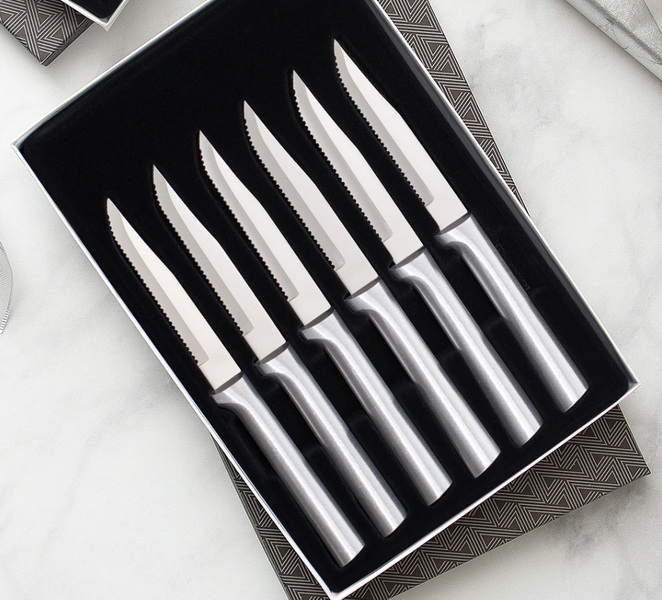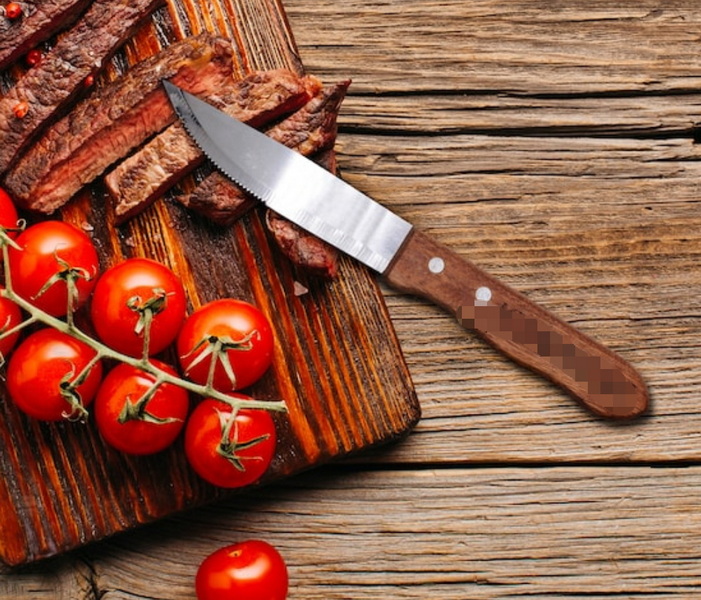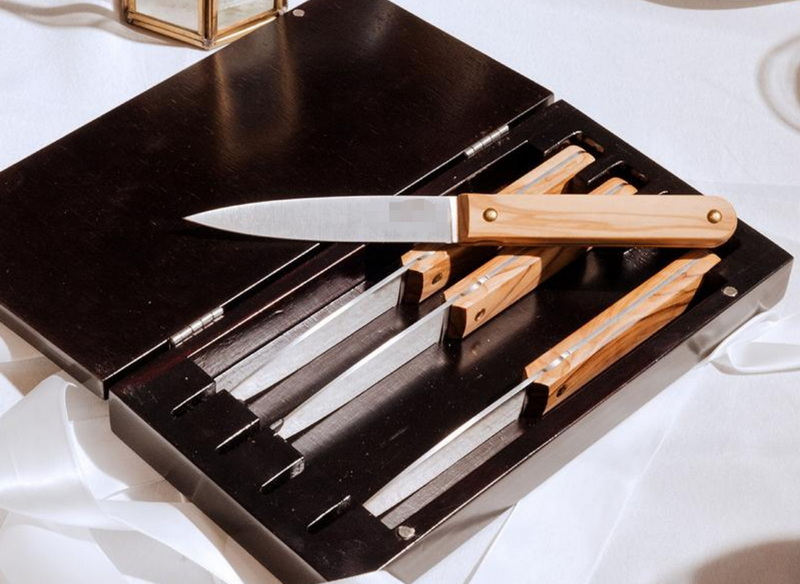- All
- Product Name
- Product Keyword
- Product Model
- Product Summary
- Product Description
- Multi Field Search
Views: 222 Author: Ann Publish Time: 2025-10-30 Origin: Site











Content Menu
● Key considerations when choosing steak knives for gifts
>> Blade geometry and performance
>> Build quality and OEM capabilities
>> High-carbon stainless steel
>> Carbon steel
>> Damascus and layered steels
● Handle materials and ergonomics
>> Wood-based handles (pakkawood, rosewood, walnut)
>> Synthetic composites (polypropylene, micarta, fiberglass-reinforced polymers)
>> Metal or metal-backed handles
● Gifting packaging and branding ideas
>> Customization options for OEM partners
● Choosing steak knives for different gifting scenarios
>> Hospitality and brand partnerships
● Care and maintenance best practices
>> Storage tips
>> Special care notes for carbon steel
● Design trends and market insights for 2025–2026
● Comparison: Selecting steak knife sets vs individual knives
● Implementation plan for OEM partners
● FAQ
>> What is the best material for a steak knife used as a gift?
>> How should I care for carbon steel steak knives?
>> Are Damascus-steel steak knives worth the higher price?
>> What packaging features enhance gift perception?
>> Can I customize handles and logos for OEM gifts?
Selecting steak knives as a gift combines practicality with pleasure, delivering a tactile reminder of quality dining experiences. For OEM partners serving international brands, a well-constructed guide helps buyers distinguish value, material science, and design ergonomics. This article walks you through key considerations, blade geometry, handle design, materials, maintenance, packaging ideas, and gifting contexts. Throughout, the term Steak Knife appears as a core SEO anchor to support search visibility across markets.

- Home gourmets, professional hosts, corporate gifting, and brand collaborations all have different expectations for style, performance, and packaging. For OEM programs, it is prudent to offer a tiered lineup that can scale from mid-market gift sets to premium collections, ensuring consistent branding across price points.
- Stainless steels for corrosion resistance and ease of maintenance.
- Carbon steels for exceptional sharpness and edge retention, with care requirements.
- Damascus or layered steels for premium visual appeal and marketing differentiation. When choosing Damascus, emphasize the construction method and edge consistency to reassure buyers about practicality as well as aesthetics.
- Narrow, pointed tips for precision slicing.
- Beveled edges versus 3-stone micro-serration considerations for different cutting tasks.
- Rockwell hardness ranges and how they relate to edge stability under repeated use. Providing a clear range (e.g., 56-62 HRC for many premium stainless options) helps buyers compare products reliably.
- Full tang with ergonomic profiles improves balance and control.
- Materials: pakkawood, synthetic composites, resin-embedded woods, or triple-riveted handles for durability.
- Bolster and tang integration affect weight distribution and finger protection. For gift sets, consider color-consistent handles across the range to reinforce uniform branding.
- Fit-and-finish, tang alignment, and consistency across sets are critical for premium gift lines.
- Packaging quality, branding capabilities, and material safety are essential for gift readiness. Establish standardized QC checks for blade flatness, edge alignment, and handle fit before packaging.
- Cleaning guidelines, drying practices, and storage tips to maximize longevity.
- Maintenance notes for carbon steel options, including seasoning and oiling schedules. Including a care card with the gift set adds perceived value and reduces post-purchase hesitancy.
Material spotlight: steak knife blade choices
- Pros: corrosion resistance, low maintenance, dishwasher-friendly options.
- Cons: edge retention may be lower than high-carbon options.
- Pros: balance of hardness, edge retention, and rust resistance.
- Cons: requires careful drying and occasional maintenance to prevent staining.
- Pros: exceptional edge sharpness and ease of re-sharpening.
- Cons: higher corrosion risk and maintenance needs.
- Pros: distinctive aesthetics, marketing appeal, potential for enhanced rigidity.
- Cons: typically higher cost and variable edge retention depending on construction. When marketing Damascus, pair the story with practical care guidance to avoid misunderstanding about maintenance.

- Pros: premium feel, natural warmth, aesthetic appeal.
- Cons: potential moisture sensitivity; require drying and occasional oiling.
- Pros: excellent durability, slip resistance, easy care.
- Cons: may lack the tactile warmth of wood.
- Pros: extreme durability and bold design statements.
- Cons: can be heavier and less forgiving for casual users. For gift sets intended for broad markets, a balanced weight offering tends to be best.
- Magnetic closures, suede or velvet lining, and serialized branding for exclusivity.
- Clear labeling of material, hardness, and warranty information.
- Logo-embossed blades, branded packaging sleeves, and color-matched handles.
- Co-branding capabilities for corporate gifts or hospitality programs.
- Recyclable or reusable packaging designs that align with sustainability trends. Demonstrating eco-conscious choices can be a strong selling point in many markets.
- Emphasize comfort, balance, and ease of maintenance.
- Focus on branding, packaging, and gift messaging that aligns with company culture.
- Highlight durability, serviceable spare parts, and the ability to scale production for events.
- Hand wash recommended for high-end blades; dry immediately after washing.
- Honing regularly to maintain edge alignment; periodic sharpening depending on usage.
- Use knife blocks with proper slots and blocks designed to protect blades; consider magnetic strips with care to prevent dulling.
- After use, wipe dry and apply a light layer of food-safe oil to delay rust. Avoid prolonged exposure to moisture-rich environments.
- Premium aesthetics with subtle branding prints on blades.
- Build quality emphasis: balanced weight, comfortable grips, and corrosion-resistant materials.
- Packaging innovations: reusable wooden boxes, magnetic closures, and QR codes linking to care guides.
- Eco-conscious sourcing for materials and packaging. Consumers increasingly expect brands to disclose material provenance and production ethics, making transparency a competitive advantage.
- In this section, we emphasize how gift sets can deliver added value through packaging, while individual knives can strengthen a brand's premium narrative through customization.
| Feature | Sets (Gift Ready) | Individual Knives (Customization) |
|---|---|---|
| Convenience | High; includes block and presentation | Moderate; requires separate storage solutions |
| Branding opportunities | High; packaging, sleeve, and case branding | High; blade etching, handle branding, and packaging |
| Value perception | Perceived as premium when packaged well | Perceived as premium through material and finish |
| Customization scope | Broad for sets; limited by block design | High for handles, blades, and branding |
- Define target markets and price bands.
- Decide blade material mix aligned with gifting goals.
- Develop packaging templates for multiple regions.
- Create media-ready product pages with images and video guidelines.
- Establish quality control benchmarks for edge consistency and handle fit.
- Build a media kit that includes high-resolution product images, lifestyle shots, and short video clips that can be repurposed across channels.
Choosing steak knives for gifts involves balancing performance, aesthetics, and brand story. For OEM programs, a thoughtfully designed gift set that combines durable materials, ergonomic handling, and premium packaging will resonate across global markets. By aligning blade material choices, handle design, and media-ready packaging with regional preferences, you can deliver a compelling, gift-ready solution that reinforces brand value and customer satisfaction.

- High-carbon stainless steel offers a balance of edge retention and corrosion resistance, making it a versatile choice for gifting.
- Dry immediately after washing, apply a light coating of food-safe oil to prevent rust, and hand wash to maintain finish.
- They offer distinctive aesthetics and branding value; performance varies by construction. If visual impact and exclusivity are priorities, they are worth considering.
- A durable, aesthetically coordinated box or block, brand-embossed blades, and an inscription or certificate of authenticity.
- Yes. OEM capabilities include logo-etched blades, customized handle materials, and packaging branding to align with client identity.
The Ultimate Professional Knives for Halal Butchery in Middle Eastern Kitchens
Chef Knife Size Guide: Choosing Between 6″, 8″, 10″, And 12″
Custom Knife Handles: How To Design A Chef Knife That Fits Your Hand Perfectly
Chef Knife Surface Treatments Guide: From Polished Migaki To Damascus Patterns
Inside Our Professional Knife Sample Room: Quality You Can See
Universal Knife Block Buying Guide: Modern Acrylic & ABS Knife Holders for Professional Kitchens
Universal Knife Block: The Complete Guide To Modern, Hygienic Knife Storage
The Complete Guide To Red Handle Knife Sets: Style Meets Functionality in The Kitchen
Professional Knives for Halal Butchery And Middle Eastern Cuisine